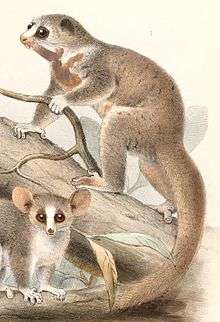Fat-tailed dwarf lemur
| Fat-tailed dwarf lemur | |
|---|---|
 | |
| Scientific classification | |
| Kingdom: | Animalia |
| Phylum: | Chordata |
| Clade: | Synapsida |
| Class: | Mammalia |
| Order: | Primates |
| Suborder: | Strepsirrhini |
| Family: | Cheirogaleidae |
| Genus: | Cheirogaleus |
| Species: | C. medius |
| Binomial name | |
| Cheirogaleus medius É. Geoffroy, 1812[3] | |
 | |
| Fat-tailed dwarf lemur range[1] | |
| Synonyms | |
| |
The fat-tailed dwarf lemur (Cheirogaleus medius), also known as the lesser dwarf lemur, western fat-tailed dwarf lemur, or spiny forest dwarf lemur, is endemic to Madagascar.
Hibernation
Recent research has shown that C. medius hibernates (or aestivates), even though in the tropical winter of Madagascar, temperatures remain high. It is the first tropical mammal and only primate in which hibernation has been demonstrated. However, the Malagasy winter is dry, and it appears that the lemur is avoiding the drought. It can hibernate for seven months. Unlike animals that hibernate in temperate regions, the lemur does not control its body temperature while hibernating, and if the tree hole in which it is sleeping is not well insulated, its body temperature fluctuates in accordance with the outside temperature.[4] During torpor, this lemur has been found to periodically enter REM sleep; non-REM sleep has not been observed, a pattern opposite that found in hibernating ground squirrels.[5] The REM sleep episodes occurred during periods of higher ambient temperature (averaging 27 C, versus an average of 20 C during nonsleeping intervals while in torpor).[5]
C. medius has a significantly longer lifespan than other strepsirrhinine or nonstrepsirrhinine primates of similar size, and this longevity is thought to be related to its status as the only primate that is an obligatory hibernator. Its maximum lifespan in captivity is nearly 30 years.[6]
Like other fat-tailed lemurs, C. medius is able to store fat in its tail, and this provides a source of energy during its period of dormancy.
Taxonomy

Between 2000 and 2009, a population of dwarf lemur was known as a separate species, the southern fat-tailed dwarf lemur (Cheirogaleus adipicaudatus). It was described by taxonomist Colin Groves as having a pelage coloration that is dark dorsally and gray ventrally, with a vaguely expressed dorsal stripe running down the back, a relatively short white median facial stripe, and black eye-rings.[7] However, in 2009, Groeneveld et al. demonstrated genetically that Cheirogaleus adipicaudatus was a synonym of Cheirogaleus medius, so the southern fat-tailed dwarf Lemur is no longer recognized as a species.[8][9]
Traits
This species is nocturnal, with a diet of insects, other small animals, fruits and flowers. The adult lemur mass is 160 grams. [10]
References
| Wikispecies has information related to: Lesser dwarf lemur |
| Wikimedia Commons has media related to Cheirogaleus medius. |
- 1 2 Andriaholinirina, N.; et al. (2014). "Cheirogaleus medius". IUCN Red List of Threatened Species. Version 2014.1. International Union for Conservation of Nature. Retrieved 2014-06-15.
- ↑ Harcourt, C. (1990). Thornback, J, ed. Lemurs of Madagascar and the Comoros: The IUCN Red Data Book (PDF). World Conservation Union. ISBN 978-2-88032-957-0. OCLC 28425691.
- ↑ Groves, C. P. (2005). "Order Primates". In Wilson, D. E.; Reeder, D. M. Mammal Species of the World: A Taxonomic and Geographic Reference (3rd ed.). Johns Hopkins University Press. p. 112. ISBN 978-0-8018-8221-0. OCLC 62265494.
- ↑ Dausmann, K. H.; Glos, J.; Ganzhorn, J. U. & Heldmaier, G. (2004). "Hibernation in a tropical primate". Nature. 429 (6994): 825–826. PMID 15215852. doi:10.1038/429825a.
- 1 2 Krystal, A. D.; Schopler, B.; Kobbe, S.; Williams, C.; Rakatondrainibe, H.; Yoder, A. D.; Klopfer, P. (2013). Seebacher, Frank, ed. "The Relationship of Sleep with Temperature and Metabolic Rate in a Hibernating Primate". PLoS ONE. 8 (9): e69914. PMC 3762832
 . PMID 24023713. doi:10.1371/journal.pone.0069914.
. PMID 24023713. doi:10.1371/journal.pone.0069914. - ↑ Blanco, M. B.; Zehr, S. M. (2015-03-18). "Striking longevity in a hibernating lemur". Journal of Zoology. 296: 177–188. ISSN 0952-8369. doi:10.1111/jzo.12230.
- ↑ Groves, Colin (2000). "The genus Cheirogaleus: Unrecognized biodiversity in dwarf lemurs". International Journal of Primatology. 21 (6): 943–962. doi:10.1023/A:1005559012637.
- ↑ Mittermeier, R.A.; Louis, E.E.; Richardson, M.; Schwitzer, C.; et al. (2010). Lemurs of Madagascar. Illustrated by S.D. Nash (3rd ed.). Conservation International. p. 183. ISBN 978-1-934151-23-5. OCLC 670545286.
- ↑ Groeneveld, L.F.; Weisrock, D.W.; Rasoloarison, R.M.; Yoder, A.D.; Kappeler, P.M. (2009). "Species delimitation in lemurs: multiple genetic loci reveal low levels of species diversity in the genus Cheirogaleus" (PDF). BMC Evolutionary Biology. 9 (30): 30. PMC 2652444
 . PMID 19193227. doi:10.1186/1471-2148-9-30.
. PMID 19193227. doi:10.1186/1471-2148-9-30. - ↑ "Lemurs of Madagascar" (PDF).
Further reading
- Schwensow, Nina; Fietz, Joanna; Dausmann, Kathrin; Sommer, Simone (September 2008). "MHC-associated mating strategies and the importance of overall genetic diversity in an obligate pair-living primate". Evolutionary Ecology. 22 (5): 617–636. doi:10.1007/s10682-007-9186-4.
- Fietz, J.; Tataruch, F.; Dausmann, K.; Ganzhorn, J. (February 2003). "White adipose tissue composition in the free-ranging fat-tailed dwarf lemur (Cheirogaleus medius; Primates), a tropical hibernator.". Journal of Comparative Physiology B. 173 (1): 1–10. doi:10.1007/s00360-002-0300-1.
